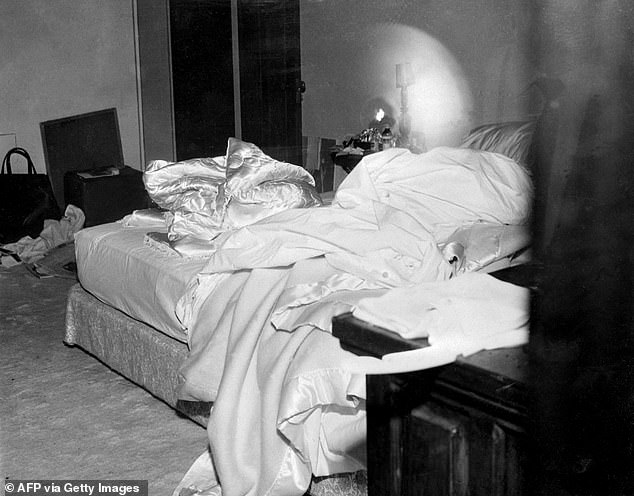Why Marilyn Monroe’s final $8.3M Brentwood home could soon be demolished
Marilyn Monroe’s former $8.3 million Brentwood home could soon be demolished as legal battles between residents and the Los Angeles City Council have extended the process.
The council voted this week to postpone a vote on whether the home’s current owners, Brinah Milstein and Roy Bank, can bulldoze the iconic home to expand their own home.
Milstein, an heir to a real estate fortune, and Bank, a reality TV producer, bought it last summer for $8.35 million and hoped to demolish it to expand their current home, which sits on the adjacent lot.
In September, Councilwoman Traci Park introduced initial consideration to historically preserve the Spanish Colonial-style home so the couple wouldn’t be able to tear it down.
The motion has since been approved by the Cultural Heritage Committee, along with the City Council’s Planning and Land Use Committee, but on Wednesday Park requested a postponement of the vote due to ongoing legal issues with the wealthy couple.
Marilyn Monroe’s $8.3 million Brentwood home could soon be demolished, as the Los Angeles City Council recently decided to postpone a vote on the home’s fate

Monroe, the most recognizable woman in the world at the time, lived in the Brentwood home for less than six months before dying of a drug overdose at age 36.
Monroe, then the most recognizable woman in the world, lived in the Brentwood home for less than six months before her untimely death from a drug overdose in 1962 at the age of 36.
According to the Daily news from Los AngelesPark said, “Following the recent court ruling and ongoing litigation, as well as the ongoing discussions between the City Attorney’s Office and property owners, I would like to continue this topic…for good cause.”
In early June, Los Angeles Superior Court Judge James Chalfant issued a preliminary ruling in favor of the city.
Last month, Milstein and Bank sued Los Angeles, claiming the conspiracy to flag the historic property will prevent them from demolishing the house later this summer.
Attorneys for the couple have filed a complaint accusing the city of code violations and conspiring with third parties to rush through the landmark process for the home that the current owners want to demolish.

Brinah Milstein and Roy Bank bought the Monroe home last summer for $8.35 million and hoped to demolish it to expand their current home, which sits on the adjacent lot.

Monroe bought the four-bedroom, three-bathroom house on Helena Drive for $75,000 in the early 1960s.
A demolition permit was initially issued for the single-family home, but now the owners claim that a “spasm of activity” among city staff has led to the start of the landmark designation process, preventing them from moving forward with their plan.
Although the house is not visible from the street — Fifth Helena Drive — fans of the late icon often stop by to deposit flowers and try to peek past the hedges to see the single-story, 2,900-square-foot home.
Monroe bought the four-bedroom, three-bathroom house in the early 1960s for $75,000.
This was her first home owned alone after the end of her third marriage to playwright Arthur Miller.
The American actress, model and singer was found dead in the bedroom of her Brentwood home in August 1962.
The cause of death was determined to be acute barbiturate poisoning, a type of depressant.

Monroe poses in front of her house in 1962, it was the only property she ever purchased and owned

The couple, as well as some other residents of the neighborhood, are convinced that designating the house as a landmark will only worsen their tourist problem.
The building has been renovated many times in recent decades. It is believed that it was first built in 1929, but it was already a very different house when Monroe bought it.
Milstein and Bank have argued that the house has again undergone an almost total transformation since the time Monroe occupied it.
“There is not a single piece of the home that contains any physical evidence that Ms. Monroe ever spent a day in the home, not a piece of furniture, not a paint chip, not a carpet, nothing,” the complaint said. to the New York Times.
The home has changed hands at least 14 times since Monroe’s death and has undergone numerous renovations with the city “taking no action regarding the home’s now perceived ‘historic’ or ‘cultural’ status,” the complaint says.

In September, Councilwoman Traci Park introduced initial consideration for historic preservation of the Spanish Colonial-style home, which would prevent the couple from tearing it down.

The bed in which Monroe overdosed on August 4, 1962
“All of these backroom machinations were in the name of preserving a house that in no way meets the criteria for a ‘Historic Cultural Monument,’ the complaint read.
Milstein has previously complained about Monroe’s fans wandering the streets of the Tony community, ringing her doorbell and asking to be let in so they could see the late movie star’s former home.
The couple, as well as some other residents of the area, are convinced that designating the house as a landmark will only worsen their tourist problem.
Since 2013, the famous house has been labeled as ‘potentially historic’ by the city’s research programme, but at no point in the past eleven years has it merited the upgrade.
